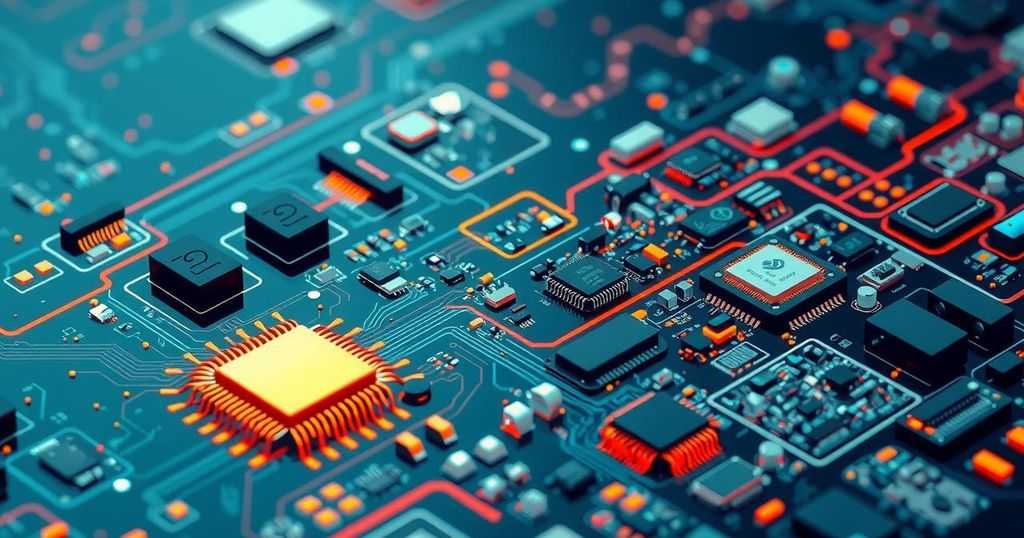The Tech Tapestry of 2024: Innovations in Semiconductors and Embedded Systems
As we venture into 2024, semiconductor design and embedded systems emerge as pivotal forces shaping the future of technology. Key trends include advancements in manufacturing processes, heterogeneous integration for compact designs, and a firm commitment to sustainability. Concurrently, embedded software evolves with a stronger focus on real-time operating systems, AI integration, and security. The collaboration between hardware and software promises to optimise performance and redefine industries, reflecting the endless potential of technological advancements.
As we step into 2024, two core domains are entwined in a dance of innovation: semiconductor design and embedded systems. These fields serve not only as the beating heart of modern technology but also as vital catalysts for future advancements across various sectors, including consumer electronics and automotive industries. Current trends indicate a relentless push towards efficiency, speed, and integration, which is reshaping our digital landscape.
The semiconductor sector is witnessing a transformative era where pushing the boundaries of Moore’s Law has led to the emergence of groundbreaking 2nm and 1nm manufacturing processes. This evolution results in chips that boast higher transistor densities, translating into robust performance and energy efficiency. However, the challenges of heat dissipation and power management persist, compelling engineers to explore cutting-edge materials like graphene and adopt innovative 3D packaging techniques such as chiplets and stacked dies.
Yet, beyond the intricacies of chips, a new trend is gathering momentum: heterogeneous integration. This technique marries distinct technologies on a singular chip, facilitating streamlined designs that combine analog, digital, and RF components. Such integration is paramount for developing tailored SoC designs that support advanced applications, particularly in artificial intelligence, ensuring devices are not only powerful but also space-efficient.
In tandem with these advancements, the semiconductor industry is committing itself to sustainability. Energy-efficient practices and greener manufacturing processes are at the forefront, with companies increasingly employing renewable energy. This commitment to environmentally friendly approaches reflects a growing consumer demand for technologies that respect the planet.
While semiconductor design focuses on hardware advancements, embedded software ensures these devices operate seamlessly. Real-Time Operating Systems (RTOS) have emerged as essential for time-sensitive applications, particularly in fields like automotive and healthcare. These systems ensure immediate data responses and real-time task management, critical in our rapidly connecting world.
Artificial intelligence is deeply influencing the evolution of embedded software, empowering devices to handle complex algorithms efficiently. This integration is particularly visible in healthcare wearables, which can monitor and analyse data instantaneously, or in automotive systems that enhance vehicle safety through advanced driver-assistance functionalities.
However, as systems grow ever-more connected, the spectre of cyber threats looms larger. In 2024, the embedded software community prioritises security at all levels, employing strategies like secure boot processes and regular updates to safeguard against vulnerabilities.
The intersection of semiconductor design and embedded software is akin to a duet where one innovation feeds into the other, creating a symphony of heightened performance and enhanced capabilities. As advancements in chip design unfold, the compatibility between hardware and software becomes increasingly paramount, leading to integrated workflows that foster collaboration and innovation.
Simulation and modelling technologies are pivotal in this joint pursuit, allowing engineers to construct virtual prototypes and refine their designs before moving to production. This pre-emptive strategy mitigates costly errors and expedites the development of groundbreaking technologies.
Looking towards the horizon, the confluence of advancements in both fields portends significant shifts across industries. The relentless miniaturisation of devices will spur developments in wearables and IoT solutions, while the automotive sector stands on the brink of revolution, powered by electric vehicle technologies and autonomous driving.
As edge computing becomes more prevalent, embedded software’s role in enabling real-time data processing will gain prominence, heralding a future of rapid decision-making and operational efficiency. The rise of collaborative approaches and open standards will facilitate the interoperability needed in today’s complex technological landscape, encouraging innovation and growth.
In summary, the dynamic interplay between semiconductor design and embedded systems is poised to redefine our future. As technological giants embrace these innovations and sustainability becomes a cornerstone of development, we stand on the cusp of a new era—where smart devices perceive, react, and transform our everyday experiences. The innovations of 2024 form a robust foundation for a world that increasingly reflects our ambitions and aspirations for a connected future.
In the rapidly evolving tech landscape leading into 2024, two intertwined sectors—semiconductor design and embedded systems—are crucial to the advancement of modern technology. These fields not only underpin current electronic devices but also hold the key to future innovations across various industries. As demand for efficiency and performance intensifies, both sectors are experiencing significant transformation driven by technological trends and consumer expectations.
The year 2024 marks a pivotal moment for the synergy between semiconductor design and embedded software, propelling advancements that will reshape industries for years to come. With innovations focusing on sustainability and efficiency, the landscape is ripe for a technological revolution. As companies harness these trends, the fusion of hardware and software capabilities promises not just smarter devices but a future replete with tangible solutions to contemporary challenges, setting the stage for unprecedented growth and innovation.
Original Source: timestech.in




Post Comment